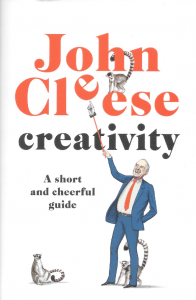The one sentence summary
There’s a myth that creativity is something that you have to be born with but this isn’t the case – anyone can be creative.
Can’t be bothered to read it? Too much screen time lately? Listen to the 5-minute podcast.
WHAT THE BOOK SAYS 
- You might think that creativity is some mysterious, rare gift – one that only a few possess. That’s not true. It’s a skill that anyone can acquire.
- Creativity is simply new ways of thinking about things. It is not the sole preserve of the arts. It can be seen in every area of life.
- Your unconscious works on stuff all the time, without you being conscious of it, and even when you think it isn’t. If you put the work in on a problem before going to bed, an idea will usually present itself the following morning.
- Our intelligent unconscious is astoundingly powerful. It allows us to perform most of our tasks in life without requiring us to concentrate on them. Put simply, you can’t ask your unconscious a question and expect a direct answer – a neat, tidy little verbal message – because the language of the unconscious is not verbal.
- In Hare Brain, Tortoise Mind, author Guy Claxton talks about two different ways of thinking:
- Hare Brain: figuring matters out, weighing up the pros and cons, constructing arguments and solving problems. Quick and purposeful.
- Tortoise Mind: proceeds more slowly, less purposeful and clear-cut, more playful, leisurely or dreamy. Meditative and pondering.
- Crucially the Tortoise Mind, for all its apparent aimlessness, is just as ‘intelligent’ as the much faster Hare Brain.
WHAT’S GOOD ABOUT IT
- There are only two differences between uncreative and creative people:
- Creative people know how to play.
- Creative people always defer making decisions for as long as allowed.
- This does not mean that creative people are indecisive. It just means that they are much better at tolerating that vague sense of discomfort that we all feel when some important decision is left open or unresolved. If you wait longer, two important things happen:
- You may get new information.
- You may get new ideas.
- The greatest killer of creativity is interruption. This can come from your own mind, or from someone or something else. So create boundaries of space to stop others interrupting you, and create boundaries of time during which the space boundaries apply.
- When you’re being creative there is no such thing as a mistake. You can’t possibly know you are going down a wrong avenue until you’ve gone down it. The longer you sit there, the more your mind slows and calms down and settles. There’s a real lack of clarity during most of the process. Don’t rush. Let these new notions of yours slowly become clearer.
- When you first have an idea, don’t be critical of it too soon.
- Other advice includes: write about what you know; look for inspiration elsewhere, borrow some of it and make an imaginative leap to take it somewhere new; get your panic in early; your thoughts follow your mood, so be in the right frame of mind to create; don’t be over-confident; test your ideas on others by asking for a second opinion and then making improvements; kill your darlings – the ideas you love but that can be made better.
WHAT YOU HAVE TO WATCH
- This is fast, wise advice and can be read in less than an hour.
